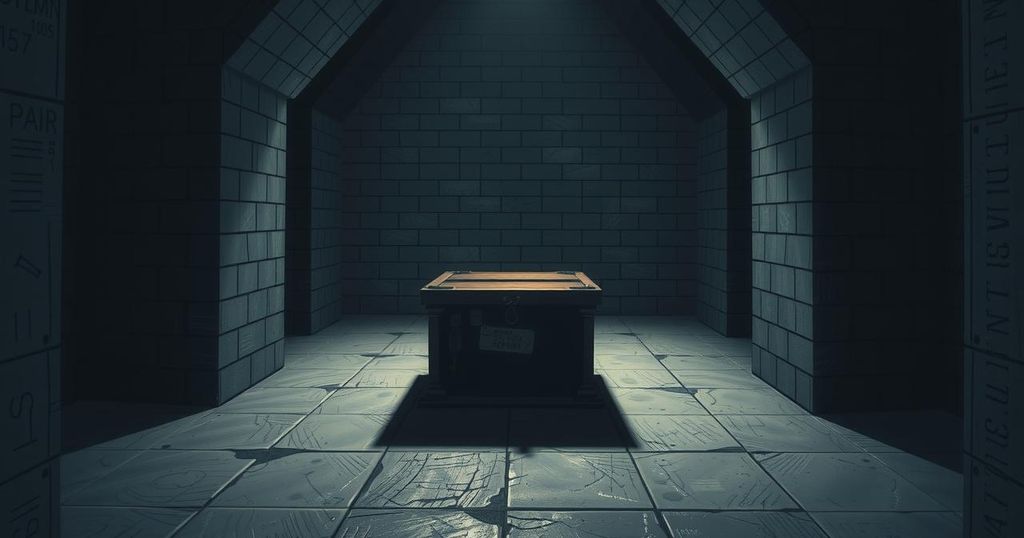Global news
ARGENTINA, ASIA, AUSCHWITZ, BRAZIL, EFE, EUROPE, FEDERATION OF, GERMANY, HUMAN RIGHTS, HUMAN_RIGHTS, IML, INTERNATIONAL LAW, ISRAEL, ISRAELI FEDERATION OF SÃO PAULO, JOSEF MENGELE, LEGAL MEDICAL INSTITUTE, MEDICAL INSTITUTE, MENGELE, MOSSAD, NAZI, PETER, PRESS FREEDOM, PUBLIC SECURITY DEPARTMENT, RICARDO BERKIENSZTAT, SÃO PAULO, SAO PAULO, SÃO PAULO PUBLIC SECURITY DEPARTMENT, SOUTH AMERICA, TECHNICAL - SCIENTIFIC POLICE
Jamal Walker
0 Comments
Josef Mengele’s Remains: A Disturbing Legacy in Brazil’s Medical Archive
Josef Mengele’s skeletal remains remain unclaimed and sealed in a São Paulo medical vault, reflecting the complexities of legal and moral obligations surrounding unaccounted war criminals. Despite their dark historical significance, Jewish community leaders advocate for minimizing attention on the remains to avoid potential veneration. The case illustrates larger issues regarding justice and remembrance as the 80th anniversary of WWII approaches.
In the heart of São Paulo, tucked away on a nondescript shelf, are the forgotten skeletal remains of Josef Mengele, a former Nazi physician infamous for his now abhorrent medical experiments during World War II. As the world approaches the 80th anniversary of the war’s conclusion, his bones remain sealed in plastic, unseen and unclaimed, symbolizing a dark chapter of history that simply refuses to fade away.
Remarkably, eight decades after the Third Reich’s downfall, Mengele’s remains are stored at the city’s Legal Medical Institute (IML). According to sources from the São Paulo Public Security Department, these bones are “stored individually, labeled with a specific number.” Brazilian regulations involve strict guidelines for unidentified or unclaimed bodies, leaving Mengele’s remains in a legal gray area. Since his family has never come forward, the IML is unable to legally dispose of the remains. A statement from São Paulo’s Technical-Scientific Police emphasized the unique nature of this case: “He is a corpse with no legal claimant, and our legislation prevents us from taking any further action.”
Amidst this bureaucratic impasse, the Jewish community has no desire to disturb Mengele’s final resting place. “We have no interest in moving them,” stated Ricardo Berkiensztat, executive president of the Israeli Federation of São Paulo, in a discussion with EFE. Concerns are prevalent over the potential for the remains to become a site of twisted reverence. The sentiments echo a broader understanding of the need to erase the spotlight from such figures, furthering the narrative of silence surrounding his actions.
Beyond the macabre storage situation, Mengele embodies a chilling reminder of the atrocities of the Holocaust. Known as the “Angel of Death,” he evaded justice for over three decades, continuing his life of quiet anonymity in South America after the war. Following his death from drowning in 1979, following years of evasion, his identity remained obscured until a concerted forensic investigation revealed the truth.
Born in Germany in 1911, Mengele’s escape from Europe began post-Nazi Germany’s fall, first finding refuge in Argentina. Throughout the years, he shuffled between countries, adopting aliases like Helmut Gregor and Peter Hochbichler to evade capture. Leading a seemingly peaceful life in Brazil until his demise, he presented himself as a family man, showing no remorse for his past.
Even in the context of his past, Mengele’s time in Brazil paints a strikingly mundane picture. He tended to his garden, read, and engaged in conversations with unsuspecting neighbors. Research by Brazilian journalist Betina Anton suggests he actively attempted to bury his horrific past. In her Jabuati Prize-winning book “Baviera Tropical,” she describes how he erased discussions of Auschwitz, reportedly harboring neither regret nor conscience over his war crimes.
At Auschwitz, Mengele’s experiments, often centered around twins and pregnant women, carried unfathomable cruelties, compelling inmates into horrific situations in the name of pseudo-science. Survivors’ accounts reveal the depths of his abnormalities—disturbing testimony from survivors narrate how he deprived mothers of their newborns to perform grotesque starvation studies.
After the war, Mengele’s route to safety led him across the South American landscape, until authorities finally confirmed his remains in 1985 after an exhaustive global investigation. By utilizing forensic science, investigators unambiguously linked the remains to him with 99.997% certainty, leaving open the question of their final resting place amid legal entanglements.
The dilemma surrounding Mengele’s remains lingers, underscoring the complexity of morality and justice. Normally, unclaimed bodies may be used for medical research or cremated, but his case presents unique challenges. Quotes from various legal experts indicate a struggle to determine a final course of action, a legal minefield left unresolved due to the notoriety and emotional weight surrounding the identity of the remains.
For many, the implications of Mengele’s life and actions still loom large. Interviewing Anton about the personal implications of her research, she disclosed a connection to the narrative: “One of my childhood teachers was among those who hid him. That story never left my mind.” Despite once integrating into local communities, there is broad disinterest from those who once tolerated him; references to him elicit acute unease.
No matter how historical perspectives may evolve, the consensus in the Jewish community is clear: it is more advantageous to let Mengele’s legacy fade. Berkiensztat again reiterated to EFE, “It is far preferable to let him remain forgotten.”
Thus, Mengele’s remains stay sealed in their plastic containers at the IML, mere objects diminished to a lifeless existence. Unlike any generic skeletons in storage, the haunting historical significance underlines the moral quandaries that persist around right, wrong, and accountability. As we head towards the landmarks of history, the tale of Mengele’s bones serves not only as a cautionary reminder of a dark past but as a powerful symbol of what happens when humanity turns a blind eye to its most horrific deeds.
Josef Mengele’s unclaimed remains continue to provoke discussions about morality, justice, and memory, serving as a grave reminder of the atrocities committed during the Holocaust. Kept in a São Paulo medical vault, these bones symbolize the complex layers of accountability and the struggle to navigate unanswered questions regarding historical legacies. The path forward remains murky, enshrined in reflections on how society remembers—and chooses to forget—past horrors.
Original Source: latinamericanpost.com




Post Comment